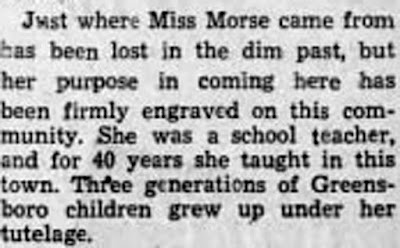Yesterday we looked at the chain of women named Sarah who inherited this New England wholecloth quilt, said to be from 1682 (A date about a century too early.)
Somehow the quilt fragment's reported chain of ownership switched families from New England to North Carolina/Alabama. The last Northern alleged owner Sarah Prout Christophers died in 1745 in Connecticut (before the quilt associated with her was actually made.) The next owner is said to be North Carolina native Sarah Pearson Croom born in 1797, 52 years later.
None of the Crooms seem to have had any New England connections so their acquisition of the quilt is a mystery---but here is a possible New England link. In looking at Alabama's Greensboro District where Magnolia Grove is a landmark, we see the home of a neighbor, "The Morse-Christian House, 1838 home of a New England school teacher."
Adeline Morse came from Massachusetts in the mid-1830s to open a school in Greensboro (a rather courageous move for a young single lady.) She bought a lot on Main Street in 1836 and opened what looks to have been a successful school for young children, which she operated for 40 years until her death in the 1870s.
After Miss Morse died, William C. Christian bought the house; he, his mother and his grandmother Augusta Hobson Tunstall (1843-1912) had been her students. (It was a small town so everyone is related---except of course Miss Morse.)
The 1870 census tells us that Adeline Morse was born about 1820 in Massachusetts. Did she fudge this date? If 1820 is accurate she'd have been about 16 when she arrived in Alabama.
Times were tough in post-Civil-War Alabama but Miss Morse could afford to live alone. Interestingly, her neighbors were all Black, the Thorpes and the Gibsons, the older people probably former slaves living in the outbuildings of the more substantial houses.
Did Adeline Morse bring quilts with her from New England in the 1830s, perhaps a whole-cloth quilt that she or one of her family members had stitched? And did she give it to a neighbor before her death in the 1870s? And to make it more special to a Sarah perhaps she created a story about a Boston quiltmaker named Sarah Kemble Knight?
Tomorrow's Post: The Sarah Kemble Knight Connection







I'm on pins and needles!
ReplyDeletePins and needles! Lol, nice one😄 seriously, I am also enjoying the intrigue. ...if only the threads in this quilt could speak
ReplyDeleteThey do speak. You just have to learn the language.
ReplyDeleteI have read The Little House books by Laura Ingles Wilder, and she taught at age 16, so I imagine that is not unusual for those times.
ReplyDelete